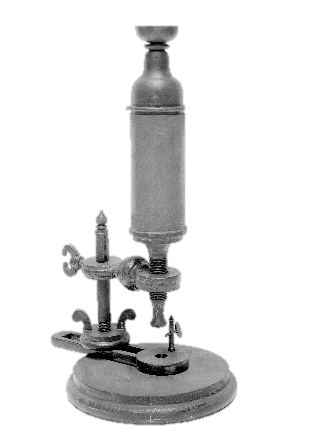
The credit of applying a microscope for the first time for the study of a biological object goes to
A. J.B. Lamarck
B. Robert Hooke
C. R.J.H. Dutrochet
D. Rudolf Virchow
Answer
547.5k+ views
Hint:The first time a microscope was used to observe a biological object is for studying the dead cell wall of a plant cell (cork). It looked similar to the cellula (rooms where monks lived) and thereby the name cell was given.
Complete solution:

Fig. Robert Hooke microscope (simple)
In 1665, Robert Hooke discovered the cell. He made a simpler version of the microscope using a single lens and transmitted light through the object for seeing a clear image. This discovery is described in his book Micrographia.
Lamarck was the first to propose a mechanism by which a slow change of species might take place. This is considered to be a large advance toward modern evolutionary theory.
Henry Dutrochet is known for investigating and describing osmosis, embryology, the effect of light on plants, and respiration.
Virchow is widely known for his cell theory, which is a great scientific contribution. He built on the work of T. Schwann.
Anton van Leeuwenhoek built his own microscope, which is as powerful as a modern daylight microscope. He was the first to observe living cells.
So, the correct answer to the question is option B.
Note: Cells are the basic unit of organisms and also the basic units of reproduction. The Cell theory or Cell doctrine theory says that all organisms are composed of similar units of the organization, which are called cells. All living organisms are composed of one or more cells. Cells arise from pre-existing cells.
Complete solution:

Fig. Robert Hooke microscope (simple)
In 1665, Robert Hooke discovered the cell. He made a simpler version of the microscope using a single lens and transmitted light through the object for seeing a clear image. This discovery is described in his book Micrographia.
Lamarck was the first to propose a mechanism by which a slow change of species might take place. This is considered to be a large advance toward modern evolutionary theory.
Henry Dutrochet is known for investigating and describing osmosis, embryology, the effect of light on plants, and respiration.
Virchow is widely known for his cell theory, which is a great scientific contribution. He built on the work of T. Schwann.
Anton van Leeuwenhoek built his own microscope, which is as powerful as a modern daylight microscope. He was the first to observe living cells.
So, the correct answer to the question is option B.
Note: Cells are the basic unit of organisms and also the basic units of reproduction. The Cell theory or Cell doctrine theory says that all organisms are composed of similar units of the organization, which are called cells. All living organisms are composed of one or more cells. Cells arise from pre-existing cells.
Recently Updated Pages
Master Class 11 Economics: Engaging Questions & Answers for Success

Master Class 11 English: Engaging Questions & Answers for Success

Master Class 11 Social Science: Engaging Questions & Answers for Success

Master Class 11 Biology: Engaging Questions & Answers for Success

Class 11 Question and Answer - Your Ultimate Solutions Guide

Master Class 11 Business Studies: Engaging Questions & Answers for Success

Trending doubts
10 examples of friction in our daily life

One Metric ton is equal to kg A 10000 B 1000 C 100 class 11 physics CBSE

Difference Between Prokaryotic Cells and Eukaryotic Cells

1 Quintal is equal to a 110 kg b 10 kg c 100kg d 1000 class 11 physics CBSE

Explain zero factorial class 11 maths CBSE

What is a periderm How does periderm formation take class 11 biology CBSE




